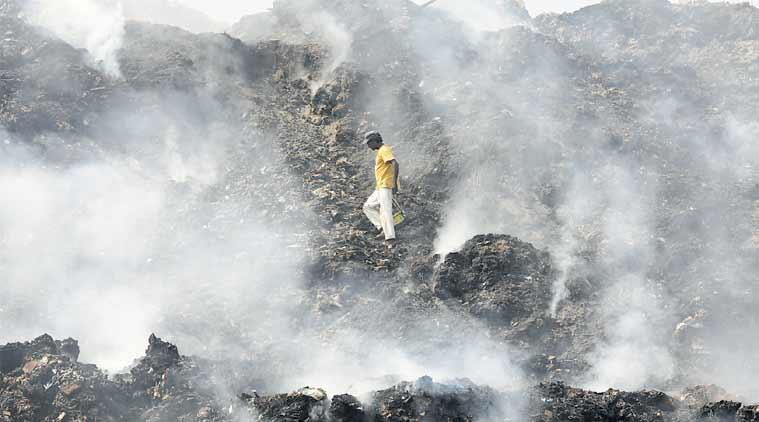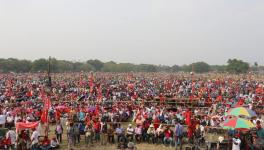Howrah Landfill Disaster Stinks of Govt Failure to Protect Citizens

Representational photo: Credit: The Indian Express
A dumping ground is an integrated urban infrastructure, which is the storage of city waste for recycling and further processing. In the present era of accelerating urbanisation, with rapid increase in population and building density in urban areas, the amount of solid waste accumulation is growing at a much faster rate. Therefore, the formation of landfill as dumping ground and its regular monitoring has become the need of the hour for solid waste management plans in Indian cities.
Dumping Ground in News Headlines
In this context, the municipal administration of metro cities has the primary role in ensuring the safety and security of such landfills. In this context, a story of a dumping ground in Kolkata made news headlines in 2018 with reference to smuggling of dead cattle meat supplied by smugglers in large number of city restaurants and food joints.
The people of Bengal faced a real cultural shock over the news of such smuggling of unhygienic buffalo meat from the dumping ground. It was the question of the safety and security of a dumping ground that raised concern among the people. An enquiry committee was constituted by the state government to investigate the crime chain in the ecosystem of the dumping ground, but till date, no one knows about the effective output of the committee’s recommendation.
Howrah Landfill Slide
However, the recent incident of a slide of the landfill located at Howrah, Belgachia has once again made news headlines. Howrah, being a 500-year-old city, is known as a twin city of the capital Kolkata. It is situated in the opposite bank of river Hooghly. The landfill, which is more than a hundred years old, was found to have suddenly settled very fast, thereby causing cracks on ground surface and along the slope of the landfill. The buildings and hutments near the dumping ground were found tilted with large visible cracks on walls and floors. The large diameter pipelines passing through the landfill were cracked from its joints due to subsidence of its supporting soil base. The concrete roads built on soft landfill soil were also cracked.
Altogether, it was an unnerving situation for the people of the locality adjacent to the dumping ground. Moreover, due to cracks in the water pipeline, supply was interrupted in a large area of Howrah Municipal Corporation for more than 72 hours, resulting in a horrible situation in the entire locality that has a population of a few lakhs.
In 2017, the Gazipur landfill collapse in Delhi had killed two persons, when 50 tonnes of the garbage mountain came crashing down.
Lethal waste dumping across India has become a major issue since the Bhopal gas tragedy. From Pirana to Pithampur, Ahmedabad to Chennai government policies of dumping one place’s garbage into another have resulted in a series of protests on a national scale.
Landfills in Urban Life
Every day, waste from households, industries, and even construction debris, is transported from main city areas to dumping grounds located on city outskirts. To keep the city waste-free, landfills near the city periphery is an essential component of urban infrastructure. Just as drainage, drinking water, electricity, and housing are vital for a city, so is the need of waste disposal to keep the city clean.
Within a city, garbage disposal vats are placed across various neighbourhoods. Under municipal initiatives, domestic waste is collected from individual homes and transported to neighborhood vats, and subsequently, it is transported to the landfills. The waste, according to its types, are sorted in a few cases before the dumping, in compliance with pollution control regulations.
Waste to Wealth
Waste is categorised into bio-degradable, non-biodegradable, and inert waste, such as road dust, broken glass, and construction debris. In Greater Kolkata, around 41% of daily waste is bio-degradable, while 37.9% is inert waste. The bio-degradable waste can be recycled into compost or used for electricity generation. Other types of waste may be recycled to produce inorganic polymers, paver blocks, and building boards.
The primary goal of waste processing is to transform garbage and waste into wealth generation. Therefore, in modern times, without proper waste processing infrastructure, landfills become ineffective. Moreover, without recycling infrastructure, the volume and height of accumulated waste in dumping areas increases continuously with the increase in built- up areas in cities. But the storage of such accumulated waste in dumping grounds cannot be unlimited. Therefore, in such cases, estimation of capacity of waste volume in a dumping ground is essential to ensure the geo-technical stability of the landfill area.
Unfortunately, in most municipal areas of West Bengal and in India, unregulated and poorly maintained landfills have grown over the years without following technical guidelines. These landfills lack systems for waste segregation, making them highly inefficient and environmentally hazardous. Despite the Swachh Bharat Mission running for over a decade, cities like Howrah still lack recycling plants at their landfill sites. In this backdrop, the West Bengal government and the municipal administration must be held accountable for this failure.
Landfill Stability Analysis
However, the fundamental issue is whether the landfill is periodically monitored by the administration in view of its capacity to store the required municipal waste volume.
The Howrah landfill is situated on soft, riverine alluvial soil and marshy land. Therefore, when the over-burden pressure of waste layers exceeds the allowable load-bearing capacity of soil, the soft soil can settle, causing large-scale subsidence.
The stability of any landfill depends on the relationship between its height, width and side slope. When the height and slope of a landfill exceeds the limiting condition, the multilayered system of waste becomes unstable. The Howrah landfill disaster was caused by piled up waste rising to the height of a 15-storey building, without proper monitoring and making a landslide inevitable.
Additionally, organic waste in a landfill produces methane, a flammable greenhouse gas, as it decomposes. Methane is lighter than air and, if not safely vented, can build up pressure, causing the landfill to crack and collapse. In the Howrah landfill, unregulated methane build-up likely contributed to the catastrophic landslide. The aftermath of the landslide has already caused differential settlement in nearby areas, damaging houses, concrete roads, and old water pipes.
Neglected Infrastructure Monitoring
In the face of this disaster, the state administration failed to protect its citizens. The state minister from Howrah district has denied their responsibility by either blaming the previous Left Front government for the construction of landfill or dismissing the incident as a natural disaster. However, the state urban development minister has claimed that the old landfill was created about a 100 years ago.
Previously, there were dumping sites in nearby areas of Kolkata’s eastern metropolitan bypass, which were abandoned after reaching the carrying capacity of those landfills and now has been transformed into green parks, including the Science City, PC Chandra Gardens, and Swabhumi, on reclaimed landfill areas.
This shows that there were examples of transformation of landfill area to other utility after completion of the service life of dumping grounds during the earlier Left Front regime (till 2011). But in that case, the continuous monitoring of such landfill should have been done by the municipal administration.
Despite Howrah being a densely populated city, its infrastructure has not kept pace with its growth. Unregulated and illegal construction has surged over the past two decades, while drainage and water supply systems remain outdated. Even after the Chief Minister's Office was relocated to Nabanna in Howrah, the city's infrastructure has witnessed no major improvement. Moreover, the Howrah Municipal Corporation has been operating without elected representatives since the past eight years, with an appointed board of administrators running the show. This lack of elected accountability has exacerbated the city's infrastructural burden.
Pollution-Free Landfill
If the government fails to learn from the Howrah landfill disaster, similar catastrophes will continue to occur across the state in different municipal areas, as most of the municipalities in Bengal lack technologically-equipped planned dumping grounds.
To prevent groundwater contamination, landfill sites should be lined with polymer sheeting to contain pollutant leachate. Moreover, dumping grounds should be located at a safe distance from residential areas, water bodies, and major roads, as per pollution control guidelines. Landfill sites should also be securely fenced with barbed wire to prevent unauthorised habitation by marginalised communities, who often suffer the most from landfill pollution.
For a safer future, the government must prioritise solid waste management not only in major cities, such as Kolkata and Howrah but also in smaller and mid-sized towns of the state. However, significant budget provision and industrial collaboration are needed to build recycling plants and landfill infrastructure.
It is to be noted that setting up a waste-processing plant is far more affordable than building a thermal power or steel plant, yet no major recycling plant has been built for years due to a lack of planning. In this context, the recent Howrah landfill disaster stands as a stark reminder of the state’s solid waste mismanagement and the dire need for sustainable waste management practices.
The writer is Professor, Department of Construction Engineering. Jadavpur University, West Bengal. The views are personal.
Get the latest reports & analysis with people's perspective on Protests, movements & deep analytical videos, discussions of the current affairs in your Telegram app. Subscribe to NewsClick's Telegram channel & get Real-Time updates on stories, as they get published on our website.
























